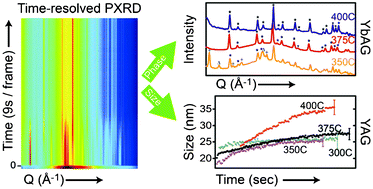In situsynchrotronpowder X-ray diffraction study of formation and growth of yttrium and ytterbium aluminum garnet nanoparticles in sub- and supercritical water†
Abstract
The formation and growth of yttrium and

* Corresponding authors
a
Center for Materials Crystallography, Department of Chemistry and iNANO, Aarhus University, Langelandsgade 140, DK-8000 Aarhus C, Denmark
E-mail:
bo@chem.au.dk
The formation and growth of yttrium and

 Please wait while we load your content...
Something went wrong. Try again?
Please wait while we load your content...
Something went wrong. Try again?
P. Nørby, K. M. Ø. Jensen, N. Lock, M. Christensen and B. B. Iversen, RSC Adv., 2013, 3, 15368 DOI: 10.1039/C3RA41854E
To request permission to reproduce material from this article, please go to the Copyright Clearance Center request page.
If you are an author contributing to an RSC publication, you do not need to request permission provided correct acknowledgement is given.
If you are the author of this article, you do not need to request permission to reproduce figures and diagrams provided correct acknowledgement is given. If you want to reproduce the whole article in a third-party publication (excluding your thesis/dissertation for which permission is not required) please go to the Copyright Clearance Center request page.
Read more about how to correctly acknowledge RSC content.
 Fetching data from CrossRef.
Fetching data from CrossRef.
This may take some time to load.
Loading related content
